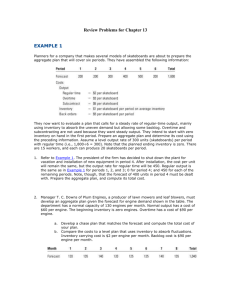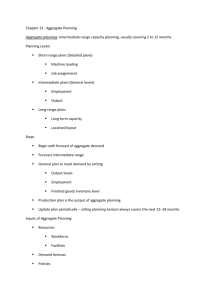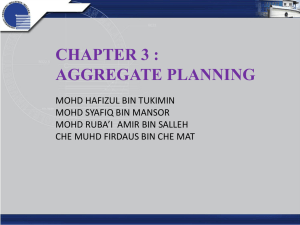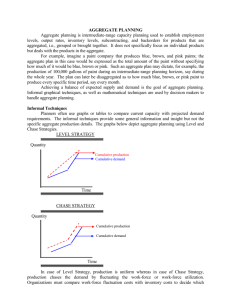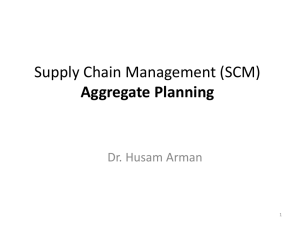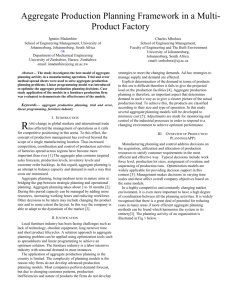Costs in Aggregate Planning
advertisement
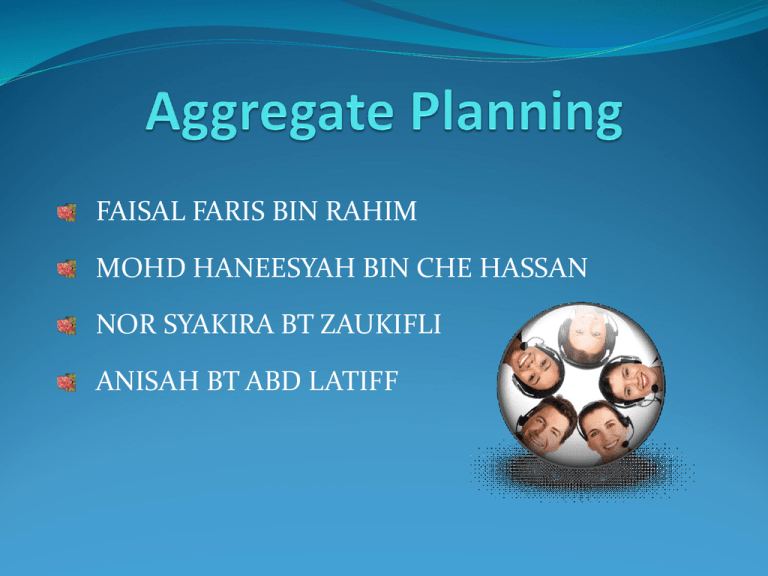
FAISAL FARIS BIN RAHIM MOHD HANEESYAH BIN CHE HASSAN NOR SYAKIRA BT ZAUKIFLI ANISAH BT ABD LATIFF Outline Costs in aggregate planning Solving in aggregate planning problem Linear decision rule (LDR) Modeling management behavior 1. 2. 3. 4. 5. 6. Smoothing Costs Holding Costs Shortage Costs Regular Costs Overtime & Subcontracting Costs Idle Time Costs Issues in Aggregate Planning Smoothing – refer to the cost of changing production and workforce level between periods. (Firing & Hiring Costs) Bottleneck Problem – Inability to respond to sudden changes in demand as a result of capacity restrictions (High demand in one period & breakdown of a vital piece of equipment) Issues in Aggregate Planning Planning Horizon- Number of periods for which the demand forecast and aggregate planning are done. If it is too small ( current aggregate plan may lead into not meeting the demand beyond planning horizon) If it is too large ( forecasts into far future will be less accurate) End-of-horizon effect Cost in Aggregate Planning 1. Smoothing Cost Hiring costs (advertising, interviewing & training) Firing costs ( lack of labor force in future) Assumed to be a linear function of the number of workers Cost in Aggregate Planning Cost of Changing the Size of the Workforce Firing costs Hiring costs Cost in Aggregate Planning 2. Holding Costs Occurs as a result of having capital tied up in inventory. Assumed to be linear in the level of inventory For aggregate planning, it is expressed in terms of dollars per unit held per planning period; (e.g. 100 $/month for one item) (e.g. 100 $/month for one item) Cost in Aggregate Planning 3. Shortage Costs Shortage occurs when demands are higher than anticipated For aggregate planning, it is assumed that excess demand is backlogged and filled in a future period. In a highly competitive situation, the excess demand may be lost---lost sales. Cost in Aggregate Planning 4. Regular Time Costs Involve the cost of producing one unit of output during regular working hours 5. Overtime or Subcontracting Costs Costs of production units not produced on regular time. Overtime-production by regular-time employees beyond work day; Subtracting-the production of items by an outside supplier; Cost in Aggregate Planning 6. Idle Time Costs Under utilization of workforce SOLVING AGGREGATE PLANNING PROBLEMS BASIC RELATIONSHIPS Workforce Number of workers in a period = Number of workers at end of previous period + Number of new workers at the start of the period- Number of laid off workers at start of the period Inventory Inventory at the end of a period = Inventory at end of the previous period + production in current period – Amount used to satisfy demand in current period Cost Cost for a period = Output Cost( Reg + OT+ Sub) +Hire/Lay off Cost +Inventory Cost +Back-order Cost A firm producing one product is scheduling (allocating) its January-March production capabilities. Part of the decision involves scheduling overtime work. A unit produced on overtime costs an extra $300. Similarly, a unit made one month before it is needed incurred an inventory carrying cost of $100; two months costs $200 per unit. The units delivered according to this schedule follows: • January - 80 units. • February - 120 units. • March - 150 units. Production capacities are: Formulate the production scheduling problem as a transportation problem and solve it by the Northwest Corner Rule. Regular Time Overtime January 100 50 February 100 40 March 100 30 Demand for Unused Total capacity capacity Supply from January February March (dummy) available (Supply) January Regular 80 20 100 Overtime 50 50 February Regular 50 50 100 Overtime 40 40 March Regular 60 40 100 Overtime 30 30 Demand 80 120 150 70 420 a) The production planner of Omega Research, a maker of industrial lenses, devised the following level output aggregate plan for the next 4 periods. Calculate the projected beginning and ending inventory for each period. Possible backorders may be shown by a negative number. Period 1 2 3 4 Demand Planned Beginning Ending forecast production inventory inventory 40,000 48,000 9,000 70,000 48,000 30,000 48,000 55,000 48,000 Period 1 2 3 4 Demand Planned Beginning Ending forecast production inventory inventory 40,000 48,000 9,000 17,000 70,000 48,000 17,000 -5,000 30,000 48,000 -5,000 13,000 55,000 48,000 13,000 6,000 Note that ending inventory = beginning inventory + planned production - demand forecast b) Develop a chase demand strategy that gradually increases the inventory level to 14,000 units by the end of period 4. Show the effect of the plan on inventory level for each period. Inventory is increased by 1250 units in each period: (14,000 - 9,000)/4 Period 1 2 3 4 Demand Planned Beginning Ending forecast production inventory inventory 40,000 41,250 9,000 10,250 70,000 71,250 10,250 11,500 30,000 31,250 11,500 12,750 55,000 56,250 12,750 14,000 c) Assume that the company currently has 10 employees and each employee, on average, can produce 4,000 units per period. Develop a staffing plan showing the number of employees that should be hired or laid off at the beginning period, using the following worksheet format. Period 1 2 3 4 Required work force Required number of employees Available at the end of previous period Hire Layoff Period Required work Required Available at the number of end of previous force employees period 1 41,250/4,000 10 10 = 10.3 2 71.250/4,000 18 10 = 17.8 3 31,250/4,000 8 18 = 7.8 4 56,250/4,000 14 8 = 14.1 Hire Layoff 8 10 6 FORMULA= Total Cost Over the TPeriod Planning Horizon FORMULA= Optimal Production Level in Period t The terms of a,b,c and d are constant that depend on the cost parameters EXAMPLE: a) Compute the values of the aggregate production level and the number of workers that the company should be using in the current period: Solution: Pt= 0.463(150) + 0.234(164)+ 0.111(185)+ 0.046(193)+ 0.993(180)– 0.464(45)+ 153 Ans:……………….. W t = 0.010D t + 0.0088D t+1 + 0.0071D t+2 + 0.0054D t+2 +0.743W t-1 – 0.01I t-1 – 2.09 Ans:…………………. THE ADVANTAGES •The result is optimal production in period t will be form. THE DRAWBACKS •The main weakness of the method is that it requires symmetric cost functions and there is no convincing argument to justify such cost curves. • The quadratic lead to LDR there is no guarantee that the solution will be non-negative. MODELING MANAGEMENT BEHAVIOR Created by Bowman (1963) Construct model for controlling production level Avoids problem arise when using traditional modeling method Exp : Avoids determine values of parameter that difficult to measure Exp : determining the accuracy of assumption that required by model. Pt = Dt 1 2 Pt = Dt + α(Pt-1 – Dt) Pt = Dt + α(Pt-1 – Dt) + β(IN – It-1) for 1 ≤ t ≥ T Not given : β, IN , α and a Not given : a 3 D = forecast demand P = production level α = smoothing factor / exponential smoothing IN = Smoothing for inventory level β = Relative weight a = for determination of P EXAMPLE Using the following values of management coefficient for Bowman smoothed production model, determine the production level should plan in the coming year with demand of 100,000 packages. Assume current production level is 150,000 packages Given : Pt-1 = 150,000 a3 = 0.556 α = 0.6 Dt = 130,000 a1 = 0.3475 a4 = 0.0663 β = 0.3 It-1 = 20,000 a2 = 0.1211 a5 = 0.0023 IN = 40,000
